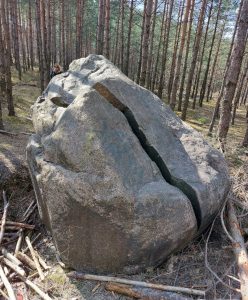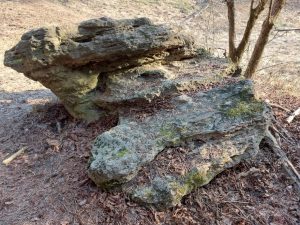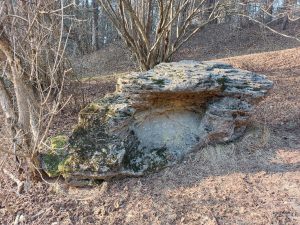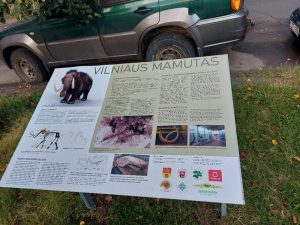Spring is already opening up trails for active nature exploration. Along with the well-known Pūčkoriai Outcrop, it is recommended to visit the geological attractions not yet marked on the park’s visitor maps: the Vidas Stone, the Antakalnis Conglomerate, and the Vilnius mammoth site (Smėlio St. 14).
The Vidas Stone: geotope – boulder, located on the edge of Pūčkoriai forest near Stepono Batoro street. Coordinates (LKS-94): X: 6062630 Y: 588740. Fine-grained (predominantly), grey-pink granitic gneiss, the rock is strongly affected by dynamic metamorphism. The boulder is 1.95 m high, 2.9 m long, 1.85 m wide, and 8.5 m in perimeter. The boulder is irregular in shape, well rounded, has signs of splitting and is split vertically throughout its height.

Vidas Stone
Antakalnic Conglomerate: geotope – rock. Coordinates (LKS-94): X: 6064948, Y: 585562. Rock parameters: 1.5 m high, 3.5 m long, 3 m wide, and 10 m in perimeter. Conglomerates are rather rare. They get formed through cementation of gravelly bedrock with calcium carbonates. This process most frequently occurred in the post-glacial period or even later. The Antakalnis Conglomerate might be not in situ but moved from its formation place during glacial periods. This is important in scientific research for dating cement.


Antakalnis Conglomerate (10.03.2025)

Stand by mammoth site, Smėlio St. 14)
Though the Pavilniai Regional Park has more than 15 excellent viewpoints from which you can admire spectacular views of the erosional hills and Vilnius, one of the most striking panoramas can be seen from the Rokantiškių viewpoint (Viršupio St. ), which should be called the highest viewpoint, as it is the highest point of the erosional hills of Vilnius (230 m a.s.l.), thus avoiding confusion with Rokantiškės Castle Site, Rokantiškės Castle Mound and Rokantiškės Hill on the eastern edge of the Pavilniai Regional Park.

Location of geoheritage objects in the Pavilniai Regional Park
Photos by Indrė Satkūnienė
Authors of the text:
Dr. Jonas Satkūnas, Laboratory of Climate and Water Research
Indrė Satkūnienė, Collections Department




